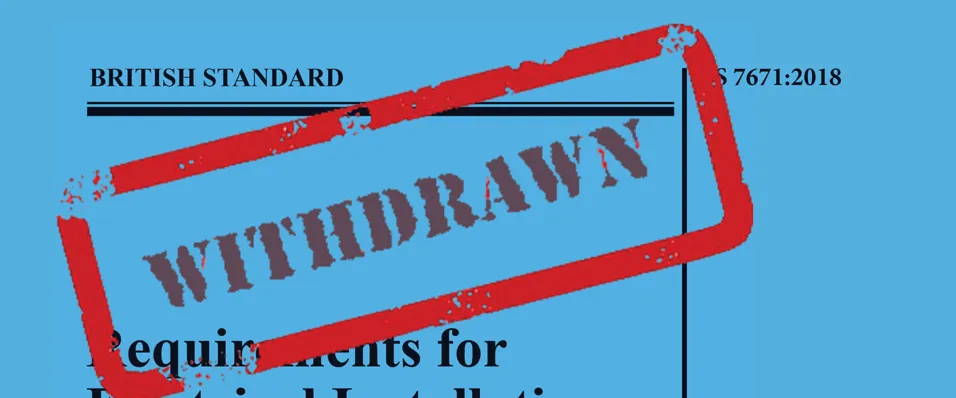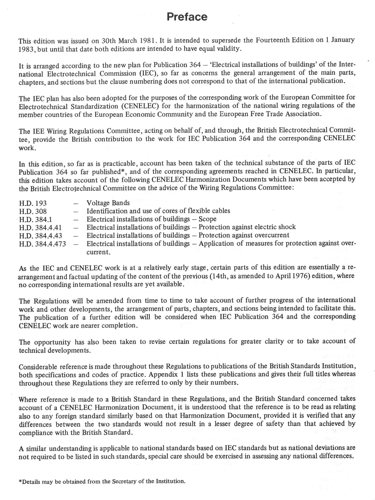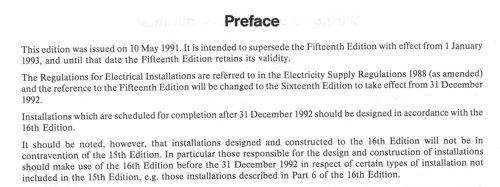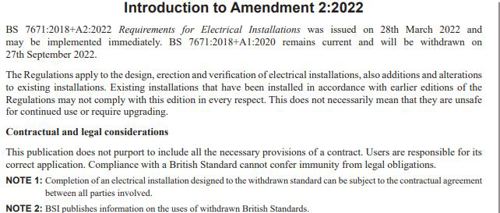
Back to the Forum: Withdrawn Standards

There has been a lot of activity on the IET EngX Wiring and the Regulations forum regarding the changes in BS 7671:2018+A2:2022 since it was published on 28 March 2022.
BS 7671:2018+A1:2020 will be withdrawn on 27 September 2022 and as the cut-off date gets closer, the IET technical helpline has received a number of related enquiries.
This article looks at what this means and how it affects existing projects.
When does BS 7671:2018+A2:2022 come into effect?
BS 7671:2018+A2:2022 was issued on 28 March 2022 and the instruction was that it can be implemented immediately, however, there is a six-month implementation period, during which time both standards have equal validity. That means the designer must decide which is the appropriate standard to work to during this time.
Historically, each iteration of the IEE Wiring Regulations superseded all previous editions from the date of issue. It was not until the Fifteenth Edition of the IEE Wiring Regulations in 1981 that the six-month implementation date was introduced.
Figure 1: Extract from Fifteenth Edition of IEE Wiring Regulations 1981

IEC/CENELEC standards
It was the Fifteenth Edition of the IEE Wiring Regulations where for the first time the layout was arranged according to the new plan for the International Electrotechnical Commission (IEC) standards publication, IEC 364, now numbered IEC 60364.
To facilitate free trade throughout Europe, the national wiring regulations were harmonised, and the UK became part of CENELEC, the European Electrotechnical Committee for standardisation. CENELEC is an association that brings together the national electrotechnical committees of 34 European countries. CENELEC is responsible for publication of Harmonised Documents (HDs).
The UK is obliged to adopt the technical intent of HDs within three years of publication, which is the main source of information for the content of BS 7671 and explains the need for regular amendments. The UK is no longer a member of the European Economic Community and the European Free Trade association; however, we remain a member of CENELEC.
Introduction of new amendments history
There have been many ways of describing the changeover period when an amendment was issued and came into force over the years. The first mention of this period came in the Sixteenth Edition of the IEE Wiring Regulations, which became a British Standard for the first time, BS 7671: 1992. At that time it was stated in the preface that ‘installations scheduled for completion’ should comply with the latest edition. However, this must have caused some issues as by the time BS 7671:1992+A1:1994 was published the wording had changed. It now stated that ‘installations designed after’ the implementation date should take account of the amendment to the Standard. It has remained this way since, up until now.
Figure 2: Extract from Sixteenth Edition of IEE Wiring Regulations 1991

Introduction to BS 7671:2018+A2:2022
The introduction of the term 'withdrawn standards' is not new. In BS 7671 it has been included in the introductory note to Appendix 1 since 1994, the Sixteenth Edition of the IEE Wiring Regulations (BS 7671:1992+A1:1994), as shown in Figure 3.
Figure 3: Extract from Sixteenth Edition of IEE Wiring Regulations BS 7671:1992+A1:1994

The term ‘withdrawn standards’ is now specifically included in the introduction to BS 7671:2018+A2:2022 (as shown in Figure 4) with the intention to align with other British Standards.
The text states that BS 7671:2018+A2:2022 was issued on 28 March 2022 and may be implemented immediately. BS 7671:2018+A1:2020 remains current and will be withdrawn on 27 September 2022. Effectively during the six-month implementation period, there are two current standards with ‘equal validity’.
The introduction also provides information regarding contractual and legal considerations.
Figure 4: Introduction to BS 7671:2018+A2:2022

What are withdrawn standards?
To put it simply, 'withdrawn' means no longer current which is a new term within BS 7671. This change aligns BS 7671 with other British Standards of which there are, currently, over 33,000.
British Standards are periodically reviewed, typically at a five-year maximum period. When a Standard is revised and updated, the previous edition is withdrawn and considered no longer current.
Withdrawn standards can still be useful, for example, to demonstrate the installation complied with the relevant edition which was current at that time.
For further information on uses of withdrawn standards, see the BSI website
Does an installation complying to withdrawn standards need upgrading?
No, just because the installation was to a previous edition, does not necessarily mean it is unsafe for continued use or requires upgrading. This is reinforced in the text of the introduction and the note by the HSE in the front matter of BS 7671:2018+A2:2022 as shown in Figure 5.
Figure 5: Note by HSE extracted from BS 7671:2018+A2:2022

How does this affect projects which have already been designed or are on-site?
The expectation is likely to be that the installation is completed and certified to the current edition of BS 7671, regardless of when the design or construction was completed.
The contract should take account of changes to standards and legislation during the contract period and an allowance be made. Given the predictable cycle, six-month implementation period and public consultation process which takes place twelve months before publication, it can’t be said to be unexpected.
New smaller projects, such as domestic electrical installations, will be expected to comply with BS 7671 2018+A2:2022 from 27 September 2022 as the contract is unlikely to be of significant length to justify completion to a withdrawn standard.
However, for larger projects there is inevitably a time period between design and installation which can be a challenge.
An electrical installation could be certified to the withdrawn standard subject to contractual requirements and agreement of all interested parties, for example, contractors, clients and insurance companies. However, the implications must be made clear, and it would be diligent to keep a record of the discussions and agreements and include this with the electrical installation certificate. See Note 1 to the introduction to BS 7671:2018+A2:2022, as shown in Figure 4.
Do British Standards have legal force?
British Standards do not have legal force, they are published for voluntary use. However, the note by the Health and Safety Executive (HSE) in BS 7671, as shown in Figure 5, states that ‘Installations which conform to the standards laid down in BS 7671:2018+A2:2022 are regarded by HSE as likely to achieve conformity with the relevant parts of the Electricity at Work Regulations 1989 (EAWR).’
The EAWR is made under the Health and Safety at Work Act 1974 (HSW), which is UK law, and the duties imposed by the EAWR are in addition to those imposed by the HSW Act. The HSW Act applies to all employers, employees and self-employed people. For further guidance on the EAWR, see HSR25 guidance on the Regulations published by the HSE.
In some cases, a law or contract can make reference to a British Standard, using terms such as ‘compliance with the requirements of BS 7671’, in which case compliance becomes a legal matter. For example, the Electrical, Safety, Quality, Continuity Regulations 2002 (ESQCR) requires compliance with ‘British Standard’ requirements and BS 7671 is cited for switched alternative sources of energy (Regulation 21) or parallel operation (Regulation 22). However, the British Standard can be said to support the legislation, rather than having legal force in its own right.
Why do standards need updating?
British Standards are reviewed by the technical committee at a maximum of five years. This is essential to take account of technological developments, new methods and materials, and other quality and safety requirements. The standard can either be ‘confirmed’ and remain current or revised. In the case of BS 7671, it is continually being developed and reviewed to take account of new safety requirements and newly published CENELEC harmonised documents (HDs).
There are 42 HDs that form part of BS 7671 listed in the preface to BS 7671:2018+A2:2022. When an HD is published, the UK has three years to adopt the technical intent, hence the requirement to update BS 7671 more frequently than some standards.
Summary
It is important to use the current edition of BS 7671 to ensure the latest requirements are being followed.
For larger projects, completion of an electrical installation to a withdrawn version of BS 7671 is possible, subject to contractual obligations and agreement by all interested parties. See Note 1 to the introduction to BS 7671:2018+A2:2022. However, it is important that the correct information is provided to allow an informed decision to be made and the communications are clear and documented.
British Standards do not have legal force but in some cases, compliance can become a legal matter.
Further reading
BSI – uses of withdrawn standards
BSI – why withdrawn standards can be very useful
IET EngX Wiring and the Regulations forum
Acknowledgments
- Leon Markwell
- Mark Coles
- Paul Skyrme
